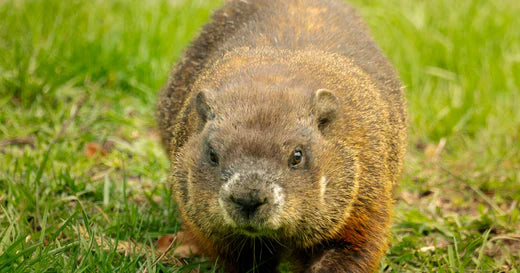Groundhogs are elusive critters that many kids may mistakenly believe are nocturnal since sightings are somewhat uncommon. These critters prefer to live a life of solitude, only coming out to eat or mate. Timid by nature, especially of humans, they poke their heads up to scan for potential threats before emerging from their safe space underground. In fact, kids will find it interesting to learn that they are likely sharing their yard with these animals, whose presence is usually only detected with the telltale sign of a bumpy trail across the property. Here are some fascinating facts about groundhogs to share with little ones next time they suspect a shy creature has made its home out back.

Facts to Share With Kids on Groundhog Day
If you ask most people what they know about woodchucks, they will probably mention the animal's namesake holiday. Children's books about Groundhog Day weave interesting information about this animal throughout funny stories about the weather. They may also mention that they burrow underground and prefer not to be seen. Due to the elusive behavior of these critters, that's usually where the knowledge ends. Well, here is some more intriguing information about the habitat, lifestyle, diet, reproduction, behavior, and role groundhogs play in their environment.
Everything to Know About Groundhogs
Kids often get a kick out of learning about groundhogs for a lot of reasons. For starters, Groundhog Day quirky and slightly silly tradition. Then there's the groundhog itself: small, furry, and undeniably cute. Children are naturally drawn to animals, and the whimsical notion of a groundhog acting as a "weather predictor" adds a charming layer to their appeal. The very idea of an animal forecasting the weather is captivating to kids. Even if they know it's just a tradition, the thought of a groundhog possessing such a special ability sparks their imagination and piques their curiosity about nature and the changing seasons. Plus, there's an inherent absurdity to the whole tradition that kids often find hilarious. The image of people eagerly waiting to see if a groundhog spots its shadow is simply funny, and children really appreciate that humor. Continue reading to learn interesting facts all about groundhogs!

(1) Groundhogs are twice the size of a newborn human baby.
On average, they are two feet long and weigh anywhere from 5 to 13 pounds. Their weight varies significantly depending on the time of the year. When these animals emerge from hibernation in early spring, they are in an emaciated state at only about 5 pounds. By fall, after enjoying several months of eating their hearts out, groundhogs tip the scale at 13 pounds. For comparison purposes, groundhogs are about the size of an average domestic cat.
(2) Groundhog's have an average lifespan of 3 to 6 years.
Groundhogs often fall victim to predators since they don't have a very strong defense system. Once they come out of hiding, there are endless, hungry animals waiting to pounce. Some of these include owls, hawks, coyotes, and foxes. Households with large dogs will occasionally be surprised that their pet killed a groundhog on the property. Also, vehicles are largely responsible for hitting groundhogs, as evidenced by remains spotted by the side of the road. When groundhogs live in captivity, protected from all the hazards that surround them in the wild, they can live up to 14 years.
(3) During warm seasons, groundhogs consume over 1 pound of vegetation every day.
When they go into hibernation, groundhogs last 150 days without eating a thing. But when they come out of hiding, the ravenous herbivores devour almost every type of vegetation within reach. Some of their favorite foods include dandelions, alfalfa, grasses, and clover. Gardeners particularly dislike the time of year when groundhogs invade their crop, like berries, corn, apples, lettuce, carrots, and just about everything else. They feed during the day, over a two-hour window, before stealthily retreating back into hiding.

(4) Groundhogs are excellent at burrowing.
They dig long, complex mazes underground.This is the only way they can survive the predatory behavior of other animals. Groundhogs are notoriously slow so running from their enemies is not an option. Fortunately, they are well-equipped to dig long burrows, spanning 40 to 60 feet. They use their sharp claws to loosen the dirt, which they then remove from the underground tunnel with their mouths to deposit at one of the entry or exit points. As time passes, the dirt mound gets covered in leaves or grass, making it almost undetectable.
(5) Groundhogs take long winter naps.
Their hibernation period spans close to five months, beginning in late fall and ending at the start of spring. During this lengthy nap, body temperatures drop to 38 degrees Fahrenheit and heart rate falls to about 4 beats a minute. While the large majority of this time is spent in a sleep state, groundhogs do occasionally emerge to relieve themselves or take brief walk, only to quickly retreat into a deep slumber. The food they consumed during the spring and summer months is enough to sustain them during the cold winter months where they stay burrowed in dens.
(6) Baby groundhogs are born blind and hairless.
Totally helpless, the newborns rely on their mother's milk for the first four weeks of life. They stay exclusively in dens for six weeks after birth until it is finally safe for them to emerge with the protection of the mother. By the time they are two months old, the offspring have started to dig their own burrows and are practically ready to live independently in dens.
(7) They are prey to numerous predators.
In areas not developed by humans, groundhogs often succumb to coyotes, foxes, bobcats, cougars, bears, and wolves. The babies are often targets of owls, hawks, eagles, and other birds of prey. Where human population is more dense, they are frequently found on the side of roads after being hit by cars. Also, large, domestic dogs can attack and kill a large woodchuck.
(8) Groundhogs are actually giant squirrels.
Groundhogs are indeed squirrels. More precisely, they're the largest members of the squirrel family- Sciuridae. They fall into a category of substantial ground squirrels called marmots. So, even though they don't look like your average bushy-tailed tree squirrel, they're absolutely related. Their scientific name is Marmota monax, and they share the same family tree as all other squirrels, chipmunks, and even prairie dogs.
(9) Their teeth never stop growing.
A groundhog's front teeth, called incisors, never stop growing – they can grow about 1/16 of an inch every week! Just like many other rodents, groundhogs have to constantly chew to keep their teeth worn down. If they didn't, their teeth would get so long they could eventually be fatal.

(10) Groundhogs are sometimes called Whistle Pigs.
Groundhogs earn the nickname "whistle-pigs" because of the loud, high-pitched whistling sound they produce. This whistle serves as a crucial alarm call. When a groundhog detects a predator, it lets out this piercing sound to alert other groundhogs nearby, prompting them to quickly retreat into their burrows. It's a highly effective way for them to communicate danger throughout their colony. The "whistle" aspect is quite literal, while the "pig" part references their somewhat stocky build.
(11) They are adept at climbing trees and swimming.
Believe it or not, groundhogs are surprisingly good at both swimming and climbing trees! While we usually think of them as burrowing creatures that stick to the ground, these skills are actually vital for their survival. They'll often take to the water to escape predators or to cross small bodies of water within their territory. Their thick fur helps them float and keeps them warm. And despite their somewhat stout and heavy build, groundhogs are also skilled tree climbers. They use their strong claws and muscular bodies to go up trees, typically to get away from danger or occasionally to reach food like fruits or tender leaves.
(12) Punxsatawney Phil drinks a special punch before predicting the weather.
According to the Punxsutawney Groundhog Club, the famous weather-forecasting groundhog, Punxsutawney Phil, supposedly sips a secret "Groundhog Punch," or "Elixir of Life," each summer during their picnic. This magical drink is said to give him another seven years of life, which helps explain his incredibly long service and continuous predictions since 1887. The actual recipe for this special "elixir" remains a closely guarded secret of the Groundhog Club's Inner Circle.







